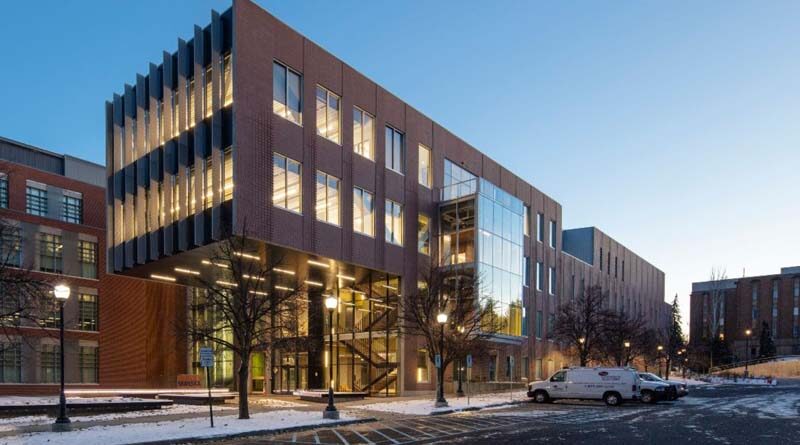Washington State University Unveils New Plant Sciences Venue
By SCN Staff
PULLMAN, Wash.—The new $66 million Plant Sciences Building at Washington State University in Pullman is now open. The latest addition to the V. Lane Rawlins Research and Education Complex, the state-of-the-art building was funded by the Washington State Legislature (WSU).
WSU is a preeminent agricultural research institution committed to fostering its land-grant heritage and tradition of service to society. The Plant Sciences Building integrates several disciplines from the College of Agricultural, Human, and Natural Resource Sciences (CAHNRS), and is central to fulfilling this mission.
The 82,437-square-foot building is a new center for interdisciplinary research and was designed and constructed by the design/build team of Skanska and LMN Architects. The project provides new infrastructure for the Institute of Biological Chemistry, as well as laboratories that integrate faculty and students in plant biochemistry, pathology, horticulture, and crop and soil sciences into a single facility.
The new five-story building supports Washington’s $51 billion food and agriculture industry by providing a modern research venue for faculty and students in the Institute of Biological Chemistry, WSU’s Molecular Plant Science Program, and portions of the Departments of Horticulture, Plant Pathology, and Crop and Soil Sciences.
“Because of the close collaboration between the architects at LMN and our college and university, we were able to design and build a truly modern facility for WSU plant research,” said CAHNRS Dean André-Denis Wright.
The project drew on participation from members of the state’s grain, tree fruit, wine, grape, potato, dairy, beef, and raspberry industries, as well as the Washington State Department of Agriculture and the Washington Farm Bureau.
The building is the fourth to be completed within the master plan for the Research and Education Complex (REC) at WSU, originally developed by LMN Architects in 2005.
“The new Plant Sciences Building marks a significant milestone in Washington State’s commitment to sustainable agriculture and ecological stewardship,” said LMN Partner Stephen Van Dyck, AIA.“As a central element of the Research and Education Complex, the new building provides state-of-the-art research facilities that are interconnected to the culture of research on the Washington State University campus. As a central node of the interdisciplinary complex, the building is designed to nurture collaborative innovation in this critical sector.”
The plan configuration of the building allows it to fulfill the master plan while accommodating an existing utility tunnel to the south—a formal adjustment to the master plan which lowered construction costs. At the western entry, the building’s cantilevered composition frames a new grand entry to the whole complex and features a two-floor cantilever facing west towards Martin Stadium.
The new facility will also be a social and interdisciplinary heart for the research complex. Designed for flexibility well into the future, the building hosts infrastructure for a variety of research needs beyond the College of Agricultural, Human, and Natural Resource Sciences. A welcoming four-floor staircase encourages vertical circulation and provides important visual connections between floors.
The interior arrangement of laboratories is designed to support efficient and flexible research over time. The modular laboratories can be easily rearranged to respond to the changing needs of research throughout the building. To the north of the modular laboratories, offices for principal investigators are interspersed with open work areas for graduate researchers. To the south of the laboratories, a series of modular support spaces accommodate a variety of specialized research equipment within easy reach of the adjacent lab benches.
On the exterior, the building reimagines the red-brick campus. The high-performance precast concrete façade panel system is clad with a sculpted, red-brick veneer. The panels integrate structure, insulation, weather barrier, interior, and exterior finishes.
Said LMN Principal Jennifer Milliron, “We have approached the design and delivery process for this building as an effort in applied research. Our Progressive Design-Build team partnered with WSU early in the process and prioritized innovative design and construction methods. Our partnership with Skanska allowed our team to explore integrated design and construction opportunities that prioritized high-performance systems, opening opportunities for architectural expression while simultaneously maximizing construction efficiencies.”

